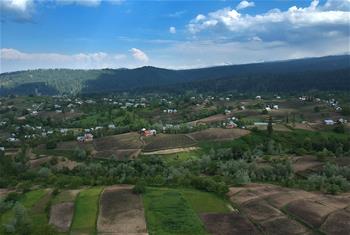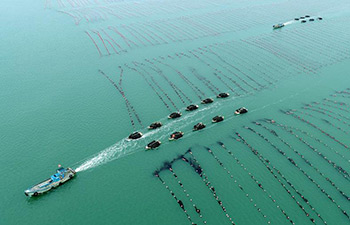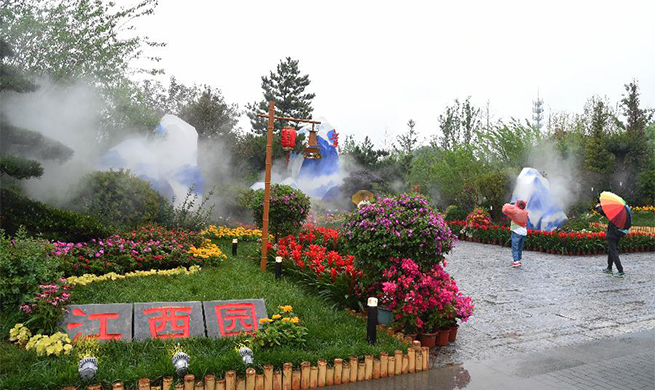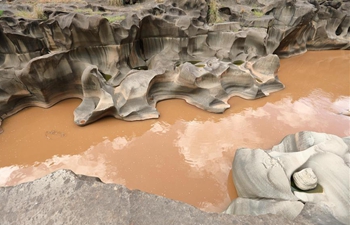by Burak Akinci
ANKARA, June 17 (Xinhua) -- Environmental experts said that the Turkish ancient town of Hasankeyf built 12,000 years ago on the Tigris River in the Mesopotamia basin, is soon to be lost forever under the waters of a dam.
According to Ercan Ayboga, spokesman of the Initiative "to Keep Hasankeyf Alive," tens of thousands of people living in the southeastern Batman province, as well as nomadic people, are facing displacement due to the development of the hydroelectric Ilisu dam, part of the massive Southeastern Anatolia Project, a major irrigation scheme aiming to save the region from drought.
This environmental engineer said that many of the people in the area have already been displaced by the authorities in recent years as the artificial flooding of the reservoir was expected to start in June and submerge Hasankeyf and nearby villages beneath 60 meters of water.
He said that "it seems for some technical reasons that his efforts are still ongoing, and possibly because of the public reaction to the project, the flooding project could be postponed for several months."
"We are calling on authorities to put the brakes on the project in order to hold a meaningful debate on how we can find an acceptable solution," to address social problems of the displaced and the faith of hundreds of ancient monuments which will be submerged, Ayboga added.
Now, the Ilisu Dam is complete about 40 km downstream Hasankeyf. The giant structure is poised to generate 3,800-gigawatt hours of electricity annually, according to the Turkish government that has decided to go ahead with the important project.
The dam, located near Iraq, will generate nearly two percent of Turkey's electricity supply, and create an 11-billion-cubic-meter reservoir essential for irrigation purposes for farming in this arid region, as well as provide electricity for modern living in Turkey as well as Iraq. However, it will inundate 300 historical sites, activists have said for years.
Local Kurdish residents generally understand the need for energy supply but are also sad that they will eventually lose their home town.
"There are other ways for energy supply such as solar and wind energy models," said Ridvan Ayhan, 56, who was born and raised in Hasankeyf.
Ayhan explained that he was born in one of the many Neolithic caves located in the area used until the 1970s as dwellings by the locals.
Now turned into an activist over the years against the Ilisu dam, he insisted that "a dam which will have a lifespan of 50 years will engulf a history of 12,000 years, and this is something that we are not ready to accept."
Only a small portion of the archeological sites around Hasankeyf have been unearthed so far in a race against time by archeologists who fear that historical artifacts will be lost forever once the authorities give their green-light to the flooding in the next weeks.
Local authorities are also working to rescue the important historic sites of Hasankeyf by gradually moving them to the park before the construction of the dam is completed.
A 12th-century Islamic monastery, an 800-year-old bathhouse, or hamam in Turkish, and the 650-year-old Zeynel Bey tomb have already been moved to the new Hasankeyf Cultural Park.
Now there is less than 3,000 residents left in Hasankeyf as most of them have been displaced to a newly constructed village about two km away, above the reservoir's water line, where it is expected that they adapt to the new situation.
A final lawsuit in the European Court of Human Rights was rejected in spring on the ground that the protection of an individual's cultural heritage is not a universal right.
Archeologists believe that Hasankeyf's history began 12,000 years ago, based on Neolithic remains found in the surrounding caves. Over the centuries, as the Tigris River became an important Silk Road thoroughfare, Hasankeyf passed through the hands of the Assyrian, Ayyubid and Ottoman Empires.
After the discovery of Neolithic remains, scientists believe the caves of Hasankeyf were settled as early as 10,000 BC. When the area is flooded, many archeological sites will be inaccessible.
Environmentalists also fear that the delicate ecosystem of the Tigris River basin, home to some of the world's earliest civilizations, will be disrupted forever.



















